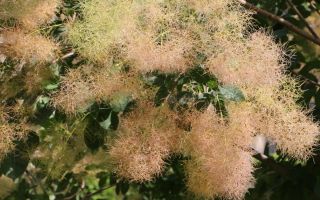Content
The properties of scumpia deserve careful study, since the plant is often found in traditional medicine recipes. Healing raw materials are used to treat inflammatory processes, but when using it, possible contraindications must be taken into account.
What it looks like and where it grows
Skumpia (Cotinus coggygria) is a deciduous shrub, sometimes a tree, from the Anacardia family. Reaches 5 m in height, has a highly branched root system and bare, shiny shoots with brown-brown bark. The leaves of the scumpia are simple, round or egg-shaped with a solid edge, arranged in regular order on the petioles. The upper surface of the plates is smooth, there is slight pubescence below.
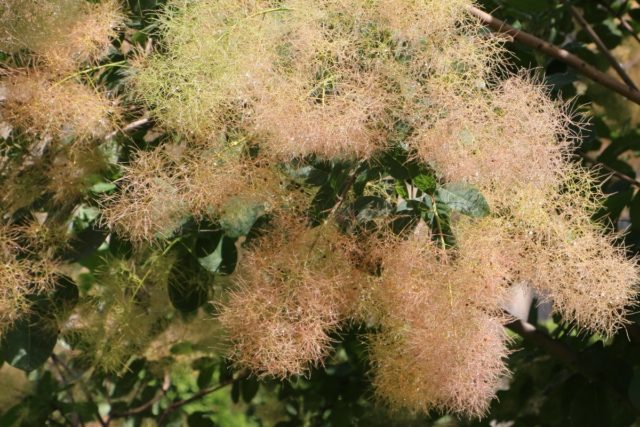
In May and June, the scumpia produces small yellowish or greenish-white flowers, collected in very fluffy panicles up to 30 cm long. The shrub is pollinated by insects, in August it bears fruit - kidney-shaped greenish drupes, which darken and veined when fully ripe.
Scumpia is widespread in southern Western Europe, Turkey, Syria, Pakistan and India. It is also found in China, and in Russia it grows in the Caucasus, in the Voronezh and Rostov regions. It usually settles on dry soils at an altitude of about 1000 m above sea level, loves rocky talus. Scumpia can grow alone, but more often forms groups of several shrubs.
Chemical composition
The healing properties of scumpia are due to its rich chemical composition. The leaves and flowers of the plant contain:
- vitamin C;
- flavonoids and carboxylic acids;
- tannins and tannins;
- vitamin A;
- tocopherol;
- natural sugars;
- gallotanin;
- gallic and caffeic acids.
Due to the high concentration of active substances, products based on the leaves and buds of the plant should be used with caution. But in small doses, they can have a beneficial effect on the body.
Useful properties of scumpia
Scumpia leaves and flowers, when used correctly, help in the treatment of chronic diseases and strengthen the body. In particular:
- fight inflammation and eliminate bacterial processes;
- have a diuretic effect and help with edema;
- remove slags and toxic substances from the body;
- cleanse the liver and kidneys, flush out small calculi from the urinary tract;
- improve the outflow of bile;
- have a beneficial effect on the state of blood vessels and serve as the prevention of atherosclerosis;
- have a wound healing effect and help with cuts and burns;
- relieve inflammation in the oral cavity in dental diseases.
Scumpia can be used as a safe natural pain reliever. Due to the high concentration of tannins, the leaves of the plant have fixing properties and help with diarrhea.
Preparation and application methods
On the basis of flowers and leaves of medicinal scumpia, water decoctions and infusions are prepared, as well as agents for external use.In all forms, the plant has a good healing effect, but requires compliance with safe dosages.
Infusion
An infusion of medicinal scump is prepared for ulcers, gastritis and after severe poisoning. The recipe looks like this:
- dry leaves of the plant are crushed in the volume of a small spoon;
- pour 250 ml of boiling water into a glass container;
- leave under the lid to infuse for an hour;
- filter.
You need to take a healing agent in 20 ml three times a day on an empty stomach.
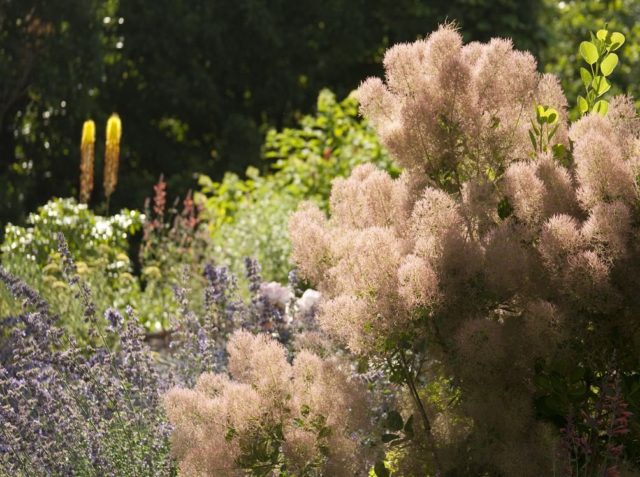
Decoction
In case of diseases of the mouth and throat, an infusion on the leaves of scumpia has a good effect. They do it like this:
- 10 g of dry skumpia raw materials are crushed and poured into 1 liter of water;
- the pan is placed on low heat and heated for ten minutes under the lid;
- the finished product is removed from the stove and filtered.
For rinsing with angina and laryngitis, the drug is used up to five times a day in a warm form.
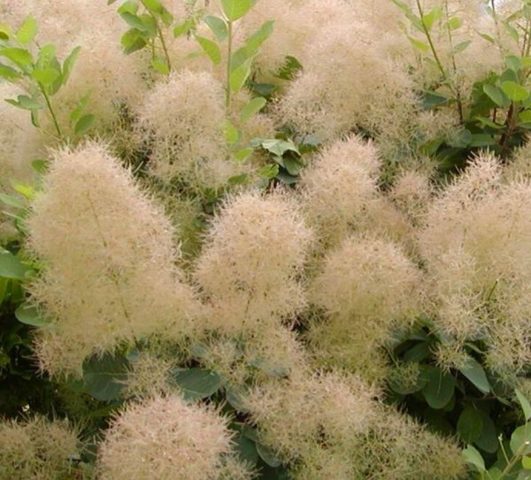
Ointment
For poorly healing wounds, skin inflammations and abscesses, you can prepare an ointment based on fresh scumpia leaves. The algorithm looks like this:
- several leaf plates of scumpia are ground by hand or with a blender until smooth;
- mixed in equal proportions with melted pork fat;
- bring to full homogeneity and put in the refrigerator for three days.
The hardened scumpia ointment is used to treat skin lesions and irritations, as well as burns in the healing phase. For the product to be of maximum benefit, it is recommended to cover it with a bandage after application.
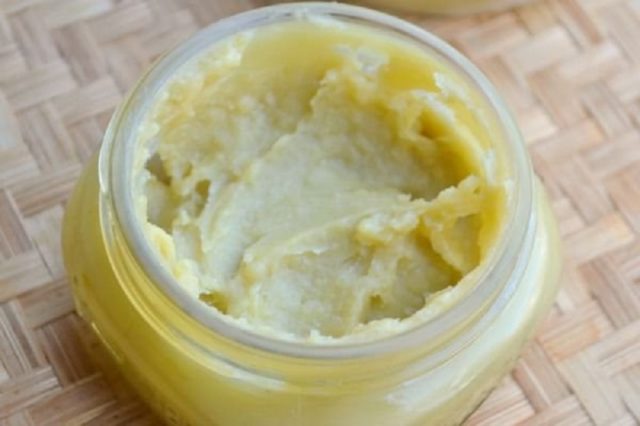
Application in traditional medicine
In home health recipes, medicinal scumpia is quite common. The plant is used for inflammatory diseases and respiratory ailments, for fevers and dermatitis.
With pleurisy and pneumonia
Scumpia is beneficial for bronchitis, pleurisy and pneumonia when combined with other herbs. Traditional medicine suggests using the following collection:
- 30 g of dry scumpia leaves are mixed with an equal amount of chamomile flowers, hyssop herb and licorice root;
- add 30 g of eucalyptus, gourd, St. John's wort and hyssop;
- mix the components and measure out six large spoons;
- plant raw materials are poured with 2 liters of boiling water;
- incubated under a lid in a large container for an hour.
The filtered collection is taken throughout the day in 100 ml. In total, you can use the product up to eight times a day.
For thrush and gynecological infections
With infectious diseases of the genital area and with thrush in women, a decoction of scumpia helps well. Prepare it like this:
- mix dried skumpia and bird highlander 10 g each;
- add 100 g of pharmacy chamomile;
- raw materials are poured in full volume with 1 liter of water;
- bring to a boil and boil over medium heat for five minutes.
The finished product is kept closed for another quarter of an hour and filtered. You need to use the broth for douching every evening until the condition improves. In addition, you can soak a sterile swab in a useful liquid and insert it into the body from night to morning.
With stomatitis and gingivitis
The anti-inflammatory properties of scumpia are beneficial for dental ailments. The following decoction helps to relieve pain and cope with bleeding gums:
- 20 g of dried skumpia is poured into 2 liters of liquid in a large saucepan;
- in a water bath, simmer closed on the stove for about ten minutes;
- removed from heat and left under the lid for another quarter of an hour;
- passed through cheesecloth.
The broth in a warm form is used several times a day for rinsing. It can also be used for angina to eliminate the bacterial process and sore throat.
At elevated temperatures
You can use the healing properties of scumpia for a severe cold, accompanied by fever. To lower the temperature, prepare the following infusion:
- dry leaves of the plant are crushed and measured out with a small spoonful of raw materials;
- pour the scumpia with a glass of fresh boiling water;
- wrap the container with towels and cover with a lid;
- kept warm for an hour for infusion;
- filter.
It is necessary to take the infusion three times a day, shortly before meals, 60 ml. You need to drink the drug in a warm form.
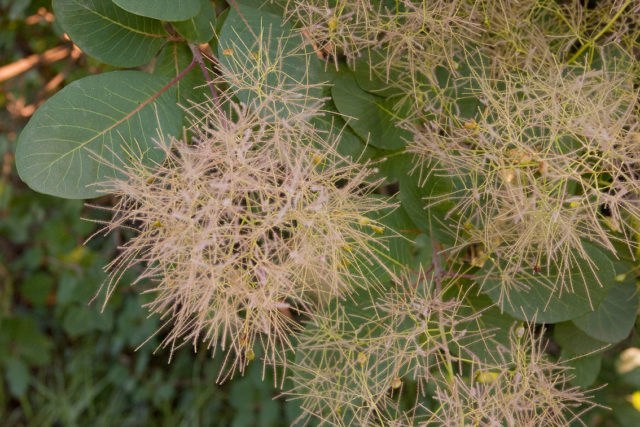
With hemorrhoids
Medicinal scumpia effectively fights inflammation and promotes the resorption of hemorrhoids. For therapy purposes, the following decoction is prepared:
- 10 g of dried plant leaves are poured into 1 liter of liquid;
- boil the product for another five minutes over medium heat after boiling;
- removed from the stove and kept for half an hour under the lid.
The filtered broth is used for compresses and lotions to the anus. It is necessary to repeat the procedures daily in the evening until the condition improves.
With diarrhea
The tannins in scumpia leaves are beneficial for intestinal upset. The following infusion helps with diarrhea:
- dry leaf plates are ground to a powder state;
- measure 10 g of medicinal raw materials and pour 500 ml of hot water;
- kept closed for an hour and filtered.
It is necessary to take the product on an empty stomach, 20 ml. The therapy is continued until the intestinal function is normalized.
Contraindications
The healing properties of scumpia must be considered along with its harmful qualities. In some cases, the use of the plant must be abandoned. You cannot use infusions and decoctions:
- with individual intolerance to the plant and its individual components;
- during pregnancy and lactation;
- with serious chronic liver diseases;
- with a tendency to severe constipation.
Since scumpia contains toxic substances, the plant is not offered to children under 12 years old. When using the leaves and flowers of the shrub for medicinal purposes, you must adhere to the recommended dosages. Excessive volumes lead to the development of side effects, including nausea, vomiting, abdominal pain and skin rashes.
Collection and procurement
For medicinal purposes, mainly the leaves and flowers of the scumpia are used. It is necessary to harvest them from May to August, during the period of the plant's decorative effect, when there are especially many vitamins and tannins in the green parts.
A warm day without precipitation is chosen to collect scumpia. It is necessary to cut from the branches only whole, well-developed plates without black dots, spots and holes, indicating fungal infections or the presence of pests. The shoots themselves do not need to be touched, they are not used for medicinal purposes.
The harvested leaves and flowers of the scumpia are washed, laid out in an even layer under a canopy in the fresh air and left until the moisture evaporates. From time to time, the raw materials are turned up. In bad weather, you can place flowers and leaves in a warm room, it is only important to make sure that no direct sunlight falls on them. It is allowed to use a dryer or oven for quick processing, provided that the appliances are heated to a maximum of 50 ° C.
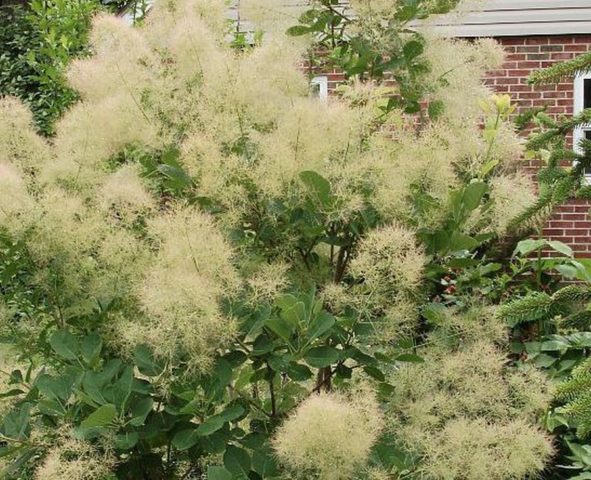
After the leaves and flowers have lost all moisture and begin to crumble in the hands, the scumpia will remain to be poured into a paper bag. Store raw materials in a dark place with low humidity.
Conclusion
The properties of scumpia are beneficial for gastrointestinal disorders, inflammation and dermatological ailments. The leaves and flowers of the shrub can be applied internally and externally, but it is important to adhere to dosages to prevent poisoning.

